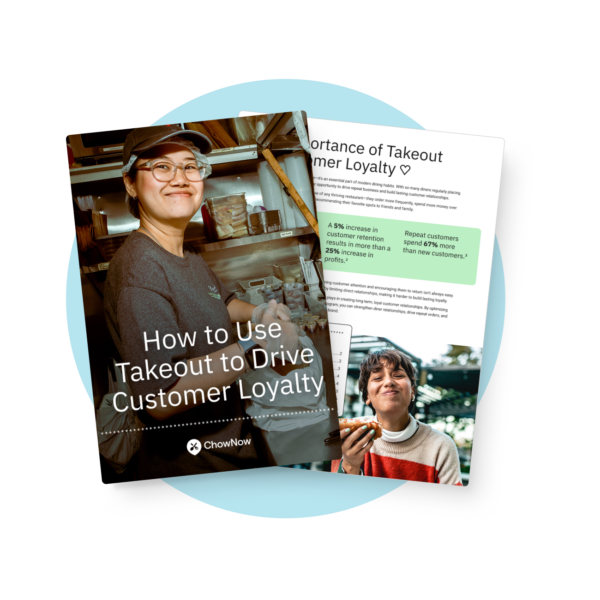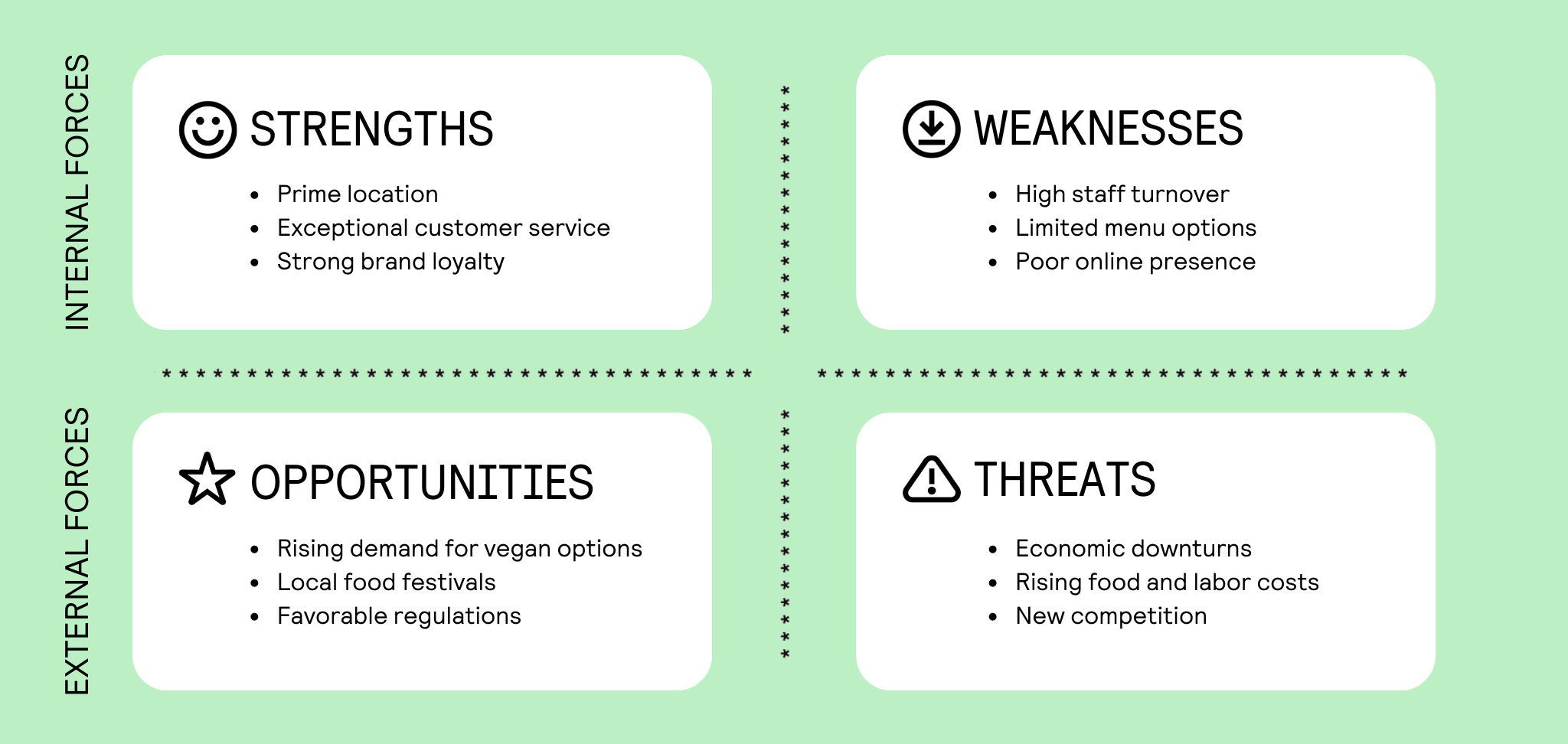Step by Step Guide to Conduct a Restaurant SWOT Analysis

Running a successful restaurant doesn’t happen by luck. Instead, it requires thoughtful planning and a deep understanding of an increasingly competitive landscape. A SWOT analysis is a simple tool that can help restaurant owners stay organized and develop a clear action plan. This technique helps you understand your restaurant’s Strengths, Weaknesses, Opportunities, and Threats. This guide will walk through the steps to conduct your own restaurant SWOT analysis to make informed decisions and enhance your business plan.
What is a SWOT Analysis?
A SWOT analysis is a strategic planning tool that allows you to evaluate your restaurant’s internal and external environments to identify your competitive position. By identifying your Strengths, Weaknesses, Opportunities, and Threats, you can develop strategies to leverage your advantages, improve your weaknesses, seize opportunities, and mitigate risks.
Now, let’s dive into how to get started with your restaurant SWOT analysis.
Step 1: Gather Your Team
Involve key team members such as managers, chefs, and front-of-house staff. Their diverse perspectives will provide a comprehensive view of your restaurant’s current state and uncover insights you might miss on your own.
Step 2: Define your objective
Once you’ve gathered your team, begin by clearly defining the objective of your analysis. Identify the key goals you aim to achieve, such as improving
customer satisfaction, increasing revenue, or expanding market presence. This objective will guide your analysis to formulate effective strategies for achieving these goals.
Step 3: Create a SWOT Matrix
Use a large whiteboard, flip chart, or even a digital tool like a shared document that will make it easy for your team to collaborate. Draw a large square and divide it into four quadrants labeled: Strengths (Top Left), Weaknesses (Top Right), Opportunities (Bottom Left), and Threats (Bottom Right). This visual layout helps organize thoughts and makes it easier to see the relationships between different factors.
Here’s an example of what your matrix may look like:
Step 4: Identify Strengths
List the internal factors that are advantageous to achieving your objective. These could include a strong brand reputation, unique technology, or efficient processes.
Consider the following questions when identifying your restaurant’s strengths:
- What do customers praise about our restaurant?
- What unique offerings or services do we provide?
- What advantages do we have over competitors (location, staff, ambiance)?
- What internal resources and capabilities do we possess (skills, technology, brand reputation)?
Additional strengths may include:
- Unique menu items
- Prime location
- Exceptional customer service
- Strong brand loyalty
Step 5: Identify Weaknesses
List the internal factors that are detrimental to achieving your objective. Identifying weaknesses may be challenging, but it’s crucial to approach this task with honesty and a critical eye.
Potential weaknesses could include outdated technology, limited resources, poor location, or lack of expertise.
Here are some questions to ask yourself:
- What do customers complain about?
- Where are we lacking compared to competitors?
- What internal processes or resources need improvement?
- Are there skills or expertise we are missing?
Additional weaknesses to consider may be:
- High staff turnover
- Limited menu options
- Inefficient kitchen layout
- Poor online presence
Step 6: Identify Opportunities
Identifying external positive factors allows you to capitalize on market trends and growth areas that can benefit your restaurant. To identify these opportunities, stay informed about industry trends, monitor competitor activities, and listen to customer feedback for insights into emerging needs and preferences.
Opportunities could include market growth, emerging trends, or technological advancements.
Consider the following:
- What trends in the food industry can we capitalize on?
- Are there underserved markets or customer segments?
- What community events or partnerships can we engage in?
- How can new technology improve our operations?
Examples of opportunities may be:
- Rising demand for vegan options
- Local food festivals
- Social media marketing opportunities
- Partnerships with local farms for fresh ingredients
- Favorable new regulations
Step 7: Identify Threats
Identify external threats to help you anticipate challenges that could impact your restaurant’s success. Similar to opportunities, monitor threats by keeping track of industry news, economic changes, competitor strategies, and shifts in consumer behavior and regulatory environments.
Consider the following questions:
- What external challenges could harm our business?
- Are there new competitors in the area?
- How do economic conditions affect our customers?
- What regulatory changes could impact us?
Examples of threats may be:
- Economic downturns
- Rising food and labor costs
- Changing health and safety regulations
- New restaurants opening nearby
Step 8: Analyze and Prioritize
To effectively analyze and prioritize the components of your SWOT analysis matrix, focus on the factors that have the most significant impact on your restaurant’s goals. Rank each element (from high to low) based on its potential influence on your objective to help prioritize next steps and allocate resources effectively. Then, develop strategies based on your prioritized elements to enhance your competitive advantage or mitigate risks.
For example, if you’ve identified your social media following as an impactful strength, you may develop strategies to leverage this following to more actively engage with customers online.
Step 9: Document and Review
Compile your SWOT analysis findings and strategies into a clear, actionable report that can serve as a reference and guide for your team.
It’s important to regularly review your report, as the restaurant industry is constantly evolving with new trends, challenges, and opportunities. By revisiting your SWOT analysis on a quarterly or bi-annually basis, you can adjust your strategies to stay competitive and ensure your business remains aligned with current market conditions.
Conducting a SWOT analysis is a critical part of strategic planning for your restaurant. It helps you understand where you stand among the competition and where you need to go. Don’t forget to be honest and objective—the more accurately you assess your strengths, weaknesses, opportunities, and threats, the better prepared you’ll be to achieve your goals.
Restaurant SWOT Analysis Frequently Asked Questions
What is a restaurant SWOT analysis?
A SWOT analysis is a strategic planning tool that helps restaurant owners evaluate their Strengths, Weaknesses, Opportunities, and Threats. It provides a structured way to assess internal capabilities and external challenges to make better business decisions.
Why should I do a SWOT analysis for my restaurant?
Conducting a SWOT analysis helps restaurant owners identify what they’re doing well, what needs improvement, where growth opportunities exist, and which external risks to monitor. It’s a foundational tool for setting goals, improving operations, and staying competitive.
When should I perform a SWOT analysis for my restaurant?
It’s best to conduct a SWOT analysis during key planning periods, such as before launching a new menu, expanding locations, or setting annual goals. Many restaurants also benefit from reviewing their SWOT analysis quarterly or bi-annually to stay aligned with changing industry conditions.
Who should be involved in a restaurant SWOT analysis?
Involve team members from across departments, such as managers, chefs, and front-of-house staff. Their varied perspectives will provide a more complete and accurate view of your restaurant’s current position.
How can a SWOT analysis help me grow my restaurant?
By clearly identifying what’s working and what’s not, you can focus resources on the highest-impact areas. You can also anticipate market changes and develop proactive strategies that support long-term growth.
Check out these additional resources to help you develop a restaurant plan:







